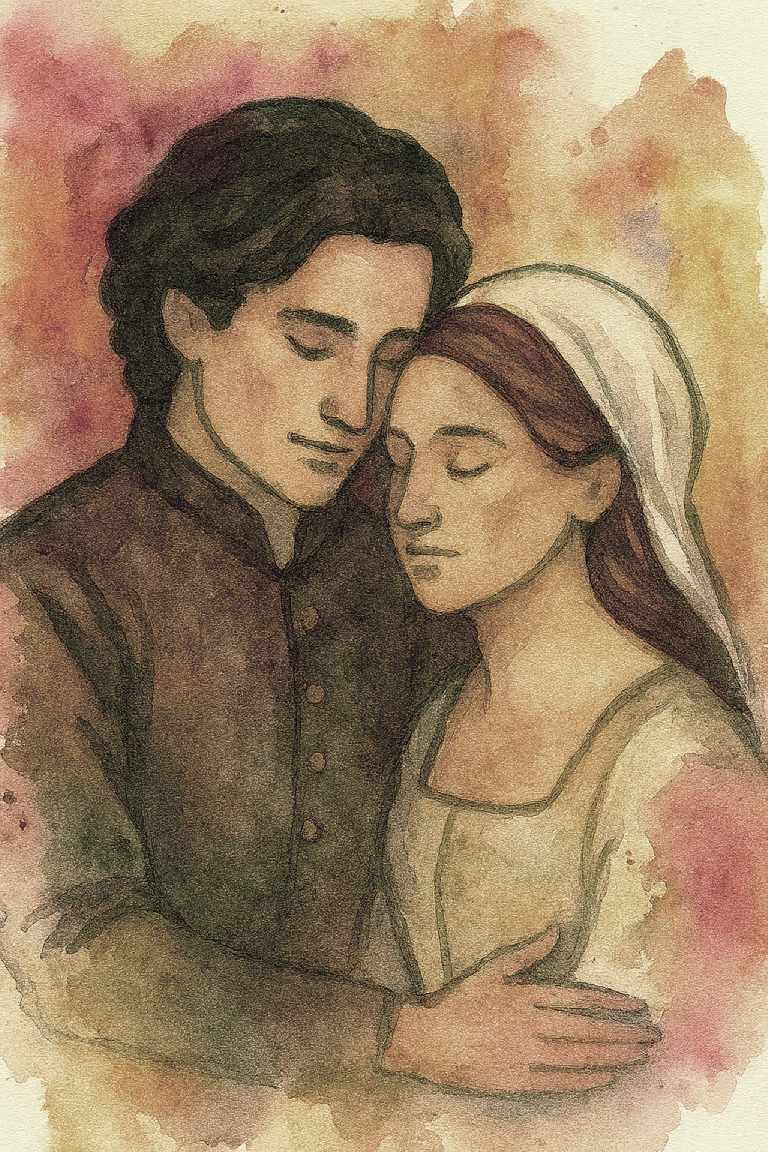Even at their most lyrical, Shakespeare’s sonnets rarely offer comfort without tension. They may open with praise or certainty, but they often carry something more unstable beneath the surface—a hesitation, a reversal, a quiet unraveling of what love is supposed to mean. This is especially true when Sonnet 116 and Sonnet 138 are read side by side. Though written in the same voice, they seem to come from two different selves: one that believes in love as a fixed truth, and one that sees it as a shared performance.
In Sonnet 116, the speaker tells us what love should be. He claims it never alters, never fades, never bends to time nor circumstance. The tone is firm, formal, and assured. Love, in this vision, stands outside of the world’s changes—it holds steady like a star. But Sonnet 138 speaks from another corner of experience. Here, love continues not because it tells the truth, but because both lovers agree to ignore it. The speaker knows he is being lied to—and then lies in return. There’s no confrontation, no plea for honesty. Just a quiet understanding that affection sometimes depends on what we choose not to say.
These two sonnets do not contradict each other so much as they frame love from opposite sides. One builds an ideal; the other reveals the compromise. Together, they offer something closer to how love actually functions: through belief and adjustment, through hope and illusion. Shakespeare gives us both the version we want to trust and the one we often live with. Not because one is true and the other false, but because love, if it lasts, must find a way to make room for both.
To read these sonnets in tandem is not to determine which is more accurate but to recognize that love, as it is lived and imagined, relies on both. It must speak its absolutes, and it must betray them. It must declare itself incorruptible, then survive its own hypocrisies. These sonnets do not correct each other. They coexist—irreconcilably, yet necessarily.
Sonnet 116 – The Ideal of Immutable Love

The speaker of Sonnet 116 begins with a firm, almost ceremonial statement:
“Let me not to the marriage of true minds /
Admit impediments; love is not love /
Which alters when it alteration finds, /
Or bends with the remover to remove.”
This is not the voice of someone exploring a personal emotion but of someone making a rule. There’s no uncertainty in the tone, no image of a relationship under strain. Instead, the speaker steps into the role of a kind of judge, one who guards the definition of love against change or error. He isn’t speaking about a specific person or experience but trying to protect an idea of love instead.
What he describes is not love shaped by experience or tested by time, but something purified of circumstance. If love can be changed by outside forces—if it “alters when it alteration finds”—then it was never real to begin with. Real love, in this vision, stays still. It doesn’t shift with time or bend when challenged. It does not respond to events but simply holds.
There is nothing tentative in this stance—the speaker doesn’t tell a story or weigh opposing feelings; instead, he lays out a fixed vision: love is constant, or it is nothing. This isn’t an observation about how people behave when they’re in love; rather, it’s a construction of what love should be, offered with the kind of certainty that doesn’t invite disagreement. The poem sets the limits of what love can be—and anything that falls outside those limits is dismissed.
After setting out what love is not, the speaker turns to what love is. His language shifts from definition to metaphor:
“O no, it is an ever-fixèd mark /
That looks on tempests and is never shaken; /
It is the star to every wand’ring bark, /
Whose worth’s unknown, although his height be taken.”
Love, in this passage, becomes something closer to a lighthouse or a star—something constant, distant, and unaffected by what happens around it. The metaphor carries weight, and it’s easy to admire the clarity of the image. But when we take a closer look, its emotional tone feels surprisingly cold. The “ever-fixed mark” may never move, but it doesn’t reach out either. It does not bend or adapt. It doesn’t notice the “tempests” it helps others endure. The star guides the lost ship, but it remains far above the storm, untouched by anything that happens below.
There’s a certain beauty in this vision of love as a stable point in a chaotic world. But it’s a beauty built on distance, not intimacy. The love described here doesn’t change because it doesn’t engage. It gives direction, but not warmth. It offers guidance, but no companionship. In trying to show that love survives change, the poem quietly removes love from the realm of human feeling.
The third quatrain continues this logic, but with a sharper edge:
“Love’s not Time’s fool, though rosy lips and cheeks /
Within his bending sickle’s compass come. /
Love alters not with his brief hours and weeks, /
But bears it out even to the edge of doom:”
Time, in this image, is no gentle presence. It is a figure holding a sickle, ready to cut down beauty and youth. The “rosy lips and cheeks” will fade, but love—true love—will not change. It will last until the end of time. Again, the speaker insists on love’s unshakable nature. But this repetition does not make love feel more alive. It makes it sound less like a feeling and more like a structure designed to outlast feeling.
It’s at this point that the poem begins to show its limits. Love here does not grow nor suffer. It does not adjust to heartbreak, betrayal, or loneliness but stands still, separate from the people who supposedly feel it. What the poem seems to need most is control—the assurance that love cannot be undone, no matter what.
That need becomes clearest in the final lines:
“If this be error and upon me proved, /
I never writ, nor no man ever loved.”
The speaker doubles down. If he’s wrong, then he has never written a single word. And no one, ever, has truly loved. It’s an extreme claim—dramatic, absolute, and designed to shut down any argument—but it also sounds defensive. There is no emotional story behind this sonnet, no memory, no pain. What we’re left with is the voice of someone insisting on certainty because the alternative is too fragile to bear.
In the end, Sonnet 116 builds a monument by shaping love into something solid and untouchable, a force that outlasts time and change. But that monument stands alone. The poem does not bring us into a moment of affection, nor does it reveal anything about how love feels. Instead, it offers a kind of shelter—an idea of love strong enough to survive whatever might threaten it. The beauty of that idea is clear, but so is its cost.
Sonnet 138 – The Intimacy of Chosen Illusions

Where Sonnet 116 presents love as a fixed truth beyond corruption, Sonnet 138 begins with the speaker recognizing a lie and accepting it anyway:
“When my love swears that she is made of truth, /
I do believe her, though I know she lies,”
There is no idealism here. The poem opens in full awareness of contradiction: the speaker knows the woman he loves is lying to him, and he chooses to believe her—not because he is fooled, but because pretending to believe her has its own rewards. This is not the kind of love that lives in purity. It survives through small negotiations and quiet understandings, spoken or unspoken.
From the first line, the difference in tone is immediate. This sonnet does not declare but confesses about the nature of love. It does not try to define it as an eternal force but instead examines what people do to keep love intact, even when honesty fails.
The speaker quickly turns the mirror on himself:
“That she might think me some untutor’d youth, /
Unlearnèd in the world’s false subtleties.”
He lies as well—not about facts, but about how much he knows. He allows her to believe he’s naïve, that he doesn’t notice the gap between her words and her truth. There’s a kind of sad cleverness in this. He pretends to believe her lie so that she can go on pretending he doesn’t see through it. Their affection, it seems, depends not on honesty but on the maintenance of illusions.
This is not a poem of heartbreak. There is no complaint, no anger, no plea for fidelity. Instead, the speaker seems almost amused by the situation. He accepts the flaws in their love because those flaws are shared. She lies; he lies; both of them know it. In this way, their shared flaws create a bond that is stronger than denial.
“Thus vainly thinking that she thinks me young, /
Although she knows my days are past the best, /
Simply I credit her false-speaking tongue: /
On both sides thus is simple truth suppressed.”
Here again, both participants play along. The speaker knows he is aging. And he knows she knows. But it’s easier for both of them to pretend that she sees him as youthful than to confront the truth of years’ decline. These mutual fictions preserve something that might otherwise vanish under the weight of realism.
“But wherefore says she not she is unjust? /
And wherefore say not I that I am old? /
Oh, love’s best habit is in seeming trust, /
And age in love loves not to have years told.”
These lines ask two rhetorical questions, but the answers are already known. The speaker wonders why she does not admit her dishonesty and why he does not admit his age. The repetition of “wherefore” doesn’t reflect confusion—it reinforces the quiet logic of their arrangement. Both know the truth; neither speaks it. Their silence is not accidental but some form of preservation.
The line “love’s best habit is in seeming trust” carries the weight of the entire poem. Trust, here, is not earned or proven. It is seeming. It resembles trust without requiring the full disclosure that trust usually demands. The couple has agreed, perhaps silently, to let the appearance of belief stand in for belief itself. There is no betrayal in this. What they protect is not truth, but closeness.
And then, almost as an aside, the speaker observes, “age in love loves not to have years told.” It’s a moment of softness, shaded with humor. He knows what time has taken, and he knows that love grows harder under the weight of years spoken aloud. So both lovers choose tact over truth. They let each other stay unexamined, because that is what affection—at this stage—requires.
The final couplet sharpens the point:
“Therefore I lie with her, and she with me, /
And in our faults by lies we flattered be.”
The pun in “lie” does much of the work. To lie means both to deceive and to sleep together. The word carries both meanings in full. Their physical relationship is entangled with their shared dishonesty, and neither element can be separated from the other. The lies are not betrayals. They are the terms of intimacy. In this poem, truth is not what makes love possible. It’s what might undo it.
Where Sonnet 116 insists that love must be rooted in something unshakable, Sonnet 138 suggests the opposite: love may last only because the people in it agree to overlook what’s real. There is no star to follow here, no “ever-fixed mark.” There is only the daily work of pretending just enough to keep the connection alive.
What the speaker offers is not cynicism but clarity. He sees the machinery behind the affection, and he names it plainly. The sonnet does not mourn this. It presents the whole arrangement without shame. Love, in this poem, is not built on truth. It is built on the decision to accept each other’s lies as gifts.
And oddly, there’s something tender in that. The lovers in Sonnet 138 are not fooled. They’re simply aware that love does not always survive scrutiny. So they let it thrive in the shadows of what they choose not to say.
Between Truth and Performance
Sonnet 116 and Sonnet 138 do not cancel each other out. They do not represent a journey from idealism to disillusionment, nor a simple contrast between purity and compromise. What they reveal, when read together, is something deeper and more disconcerting: that love may require both the idea of permanence and the practice of pretending. These sonnets speak in different registers, but they describe overlapping conditions. The need to believe in constancy and the need to bend the truth to keep affection alive are not opposites. They are neighboring instincts.
In Sonnet 116, the speaker builds a structure of love that can survive anything—time, change, error, decay. But his certainty rests on distance. The poem asks us to believe in an absolute, unyielding love that does not seem to involve real people. There is no moment of conflict or reconciliation, no failure or return. The voice describes what love ought to be, not what it feels like from inside.
In Sonnet 138, we hear what happens when love enters daily life. There is no mythmaking, no grand vow. There is simply the ongoing, quiet decision to accept what is not entirely true. The speaker and his lover are not untouched by time. They do not guide each other from afar. They meet each other where they are: aging, imperfect, and aware of the limits of honesty. Their love survives not because it resists all change, but because it adjusts itself to what both people are willing to believe.
These sonnets are not rival visions of love. They are, for all practical purposes, just different accommodations. One offers an ideal so fixed that it cannot break, and the other shows how something fragile can endure by learning when to look away. The first demands constancy; the second asks for tact. The contrast is not between truth and falsehood, but between what love promises in theory and what it learns to do in practice.
To love someone is to live somewhere between those two voices: the voice that says nothing can change love and the voice that says everything has changed, but we will carry on anyway. Shakespeare, in placing these sonnets side by side—not in sequence, but in the echo chamber of his body of work—gives us that full spectrum. He does not settle the matter. He lets the contradiction stand.
Further Reading
Shakespeare’s Sonnets by Folger Shakespeare Library
Sonnet 116: Let Me Not to the Marriage of True Minds by Karen Swallow Prior, The Priory in Substack
Sonnet 138: When My Love Swears That She is Made of Truth by Karen Swallow Prior, The Priory in Substack
Shakespeare’s sonnets by Don Paterson by Don Paterson, The Guardian





